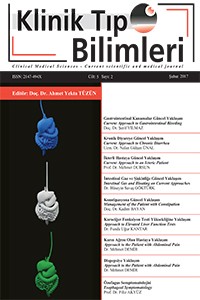Abstract
Abstract
Icterus is characterized by yellow discoloration of the skin, and related to hyperbilirubinemia. There are a number of diseases which cause hyperbilirubinemia. Liver is in thecenter of those diseases. Although it is not difficult to diagnose in most cases, on very rareoccasions, complex diagnostic tools may be needed. Generally, treatment has been ensured by the simple modalities, whereas, there are some failed treatments, despite the sophistical therapeutic approach. Prognosis is close related to etiology of icterus.
Keywords
References
- Kaynaklar 1.Roy-Chowdhury J, Roy-Chowdhury N. Bilirubin metabolism and itsdisorders. Zakim and Boyer’s hepatology: A tetbook of liver disea-se. Edited by Thomas D. Boyner, Michael P. Manns, Arun J. San-yal. 2012 (6th ed.): 1079-1109. Elsevier Saunders 2.Lidofsky SD. Jaundice. Sleisenger and Fordtran’s gastrointestinaland liver disease: pathophysiology, diagnosis, management. Editedby Mark Feldman, Lawrence S. Friedman, Lawrence J. Brandt. 2016(Tenth edition): 336-348 3.Wolkoff AW. The hyperbilirubinemias. Harrison’s principles of internalmedicine. 18th ed.7editors, Dan L. Longo…[et al.]. 2012: 2531-2537 4.Roche SP, Kobos R. Jaundice in the adult patient. Am Fam Physi-cian. 2004 Jan 15;69(2):299-304 5.Sticova E, Jirsa M. New insights in bilirubin metabolism and theirclinical implications. World J Gastroenterol. 2013 Oct14;19(38):6398-407 6.van Dijk R, Beuers U, Bosma PJ. Gene replacement therapy for ge-netic hepatocellular jaundice. Clin Rev Allergy Immunol. 2015Jun;48(2-3):243-53 7.Odievre M. Clinical presentation of metabolic liver disease. J Inhe-rit Metab Dis. 1991;14(4):526-30 8.Matsubara S, Kuwata T, Kamozawa C, et al.: Connection betweenhyperemesis gravidarum, jaundice or liver dysfunction, and biliarysludge. J Obstet Gynaecol Res.38:446-448 2012 9.Lim JH, Kim SY, Park CM. Parasitic diseases of the biliary tract. AJRAm J Roentgenol. 2007 Jun;188(6):1596-603 10.Modha K. Clinical Approach to Patients With Obstructive Jaundi-ce. Tech Vasc Interv Radiol. 2015 Dec;18(4):197-200
Abstract
Öz
Vücuttaki sarı renk değişikliği ikter olarak ifade edilir ve hiperbilirubinemi ile alakalıdır. Hiperbilirubinemiye yol açan bir dizi hastalık vardır. Bu hastalıkların merkezinde karaciğer bulunmaktadır. Tanıya varmak genellikle zor olmamakla birlikte bazen karmaşık tanısal araçlara ihtiyaç duyulabilmektedir. Basit tedbirlerle çözülebilen ikterli hastalara karşın sofistike tedavilere rağmen sonuç alınamayan vakalar da mevcuttur. Prognoz ikterin etyolojisi ile yakın alakalıdır.
Keywords
References
- Kaynaklar 1.Roy-Chowdhury J, Roy-Chowdhury N. Bilirubin metabolism and itsdisorders. Zakim and Boyer’s hepatology: A tetbook of liver disea-se. Edited by Thomas D. Boyner, Michael P. Manns, Arun J. San-yal. 2012 (6th ed.): 1079-1109. Elsevier Saunders 2.Lidofsky SD. Jaundice. Sleisenger and Fordtran’s gastrointestinaland liver disease: pathophysiology, diagnosis, management. Editedby Mark Feldman, Lawrence S. Friedman, Lawrence J. Brandt. 2016(Tenth edition): 336-348 3.Wolkoff AW. The hyperbilirubinemias. Harrison’s principles of internalmedicine. 18th ed.7editors, Dan L. Longo…[et al.]. 2012: 2531-2537 4.Roche SP, Kobos R. Jaundice in the adult patient. Am Fam Physi-cian. 2004 Jan 15;69(2):299-304 5.Sticova E, Jirsa M. New insights in bilirubin metabolism and theirclinical implications. World J Gastroenterol. 2013 Oct14;19(38):6398-407 6.van Dijk R, Beuers U, Bosma PJ. Gene replacement therapy for ge-netic hepatocellular jaundice. Clin Rev Allergy Immunol. 2015Jun;48(2-3):243-53 7.Odievre M. Clinical presentation of metabolic liver disease. J Inhe-rit Metab Dis. 1991;14(4):526-30 8.Matsubara S, Kuwata T, Kamozawa C, et al.: Connection betweenhyperemesis gravidarum, jaundice or liver dysfunction, and biliarysludge. J Obstet Gynaecol Res.38:446-448 2012 9.Lim JH, Kim SY, Park CM. Parasitic diseases of the biliary tract. AJRAm J Roentgenol. 2007 Jun;188(6):1596-603 10.Modha K. Clinical Approach to Patients With Obstructive Jaundi-ce. Tech Vasc Interv Radiol. 2015 Dec;18(4):197-200
Details
| Primary Language | Turkish |
|---|---|
| Journal Section | Makaleler 1 |
| Authors | |
| Publication Date | February 5, 2017 |
| Published in Issue | Year 2017 Volume: 5 Issue: 2 |


